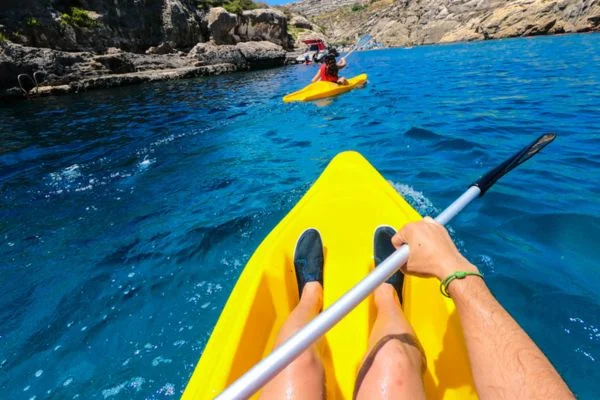If you’re planning a canoe trip, you want to ensure you wear the right shoes. Not only do you want comfortable shoes that will keep your feet dry and protected from rocks and other hazards, but you also need shoes that won’t get in the way or cause any damage to the boat. Read on to find out what kind of shoes do you wear while canoeing.
For Canoeing Choose shoes that are lightweight, quick-drying water shoes, sandals, or neoprene booties. They offer good grip, comfort, and protection for wet conditions.
Do You Wear Shoes In A Canoe?
Whether to wear shoes while canoeing may have various opinions, and many factors must be weighed when considering the right choice. For those who wear shoes in a canoe, the benefits of having extra traction with their feet outweigh the potential drawbacks of bringing shoes on board.
On the other hand, no-shoe enthusiasts may find solace in going barefoot to better connect with nature or help keep the boat stable. Ultimately, it’s up to each individual to make the best decision based on personal comfort and safety.
No matter what happens, though, wearing an approved Personal Floatation Device is a must for anyone embarking on a canoe excursion.
Also Read: How To Repair Canoe Seat?
What Kind Of Shoes Do You Wear While Canoeing?

Water Shoes
The best type of shoe for canoeing is a pair of water shoes. Water shoes provide traction when getting in and out of the boat, protect your feet from sharp rocks and debris, and, most importantly, keep your feet dry.
They should have a good grip to help prevent slipping on wet surfaces—inside and outside the canoe—and they should be lightweight enough not to strain your legs while paddling. It’s also important to look for water shoes with a secure fit, so they don’t slip off during your adventure.
Sandals
Another option is sandals with a heel strap. These are great if you want more breathability than water shoes but still need protection from sharp rocks and debris.
Sandals with heel straps also provide better stability when getting in and out of the canoe, compared to flip flops or other open-toed sandals, which can be more slippery on wet surfaces.
However, it’s important to note that sandals can give off small pieces of plastic, which may scratch or damage the inside of the canoe over time.
Flip Flops
Flip flops are generally not recommended as they offer no protection against rocks or debris, no support when getting in or out of the boat, and tend to be slippery on wet surfaces — all things that can lead to injury or an unpleasant experience on the water!
That being said, if you plan on keeping them on at all times while canoeing, they could work in certain situations, provided there aren’t any sharp objects around (like coral reefs). Ultimately though, it’s best to avoid them altogether if possible!
Also Read: How To Make A Canoe Seat Frame?
Where Do You Sit In A Canoe?
When it comes to sitting in a canoe, there is no definitive answer about the best seating position. It largely depends on the size and style of boat you’re using and how many people are paddling at once.
For instance, if you’re paddling solo in a larger canoe—one that can accommodate three or more people—the most efficient way for an individual to paddle is with their feet forward and facing towards the bow (front) of the boat.
This gives you ample room for sweeping strokes with your paddle while keeping your weight evenly distributed across the entire vessel.
Furthermore, pointing your feet forward makes it easier to pivot on them and switch directions quickly. In addition, this setup provides additional control over where the nose of the canoe points since your legs will act as stabilizing rudders when engaged properly during strokes.
However, if you’re paddling tandem (with two people) or with more than two individuals in a shorter craft, such as a whitewater kayak-style canoe, there are other considerations to consider before determining which seat should be used by whom.
Generally speaking, though both rowers should face each other from opposite ends of the canoe, they can work together efficiently and effectively synchronize their strokes without interference from each other’s efforts.
Ultimately this arrangement allows each person plenty of space so that both can use full arm lengths for productive stroke power without hindering one another’s motion during exits and entries into the water, thus resulting in maximum speed and maneuverability overall.
Also Read: How Many Seats Are In A Canoe?
Bottom Line:
What kind of shoes do you wear while canoeing? When choosing a pair of canoeing shoes, selecting one based on your needs is important. Water shoes offer maximum protection from sharp rocks or debris and adequate grip when getting in/out of the boat; however, some people may prefer more breathability offered by sandals with heel straps (although these may cause some wear/damage over time).
Flip flops should be avoided as they do not protect against rocks/debris nor have a good grip when entering/exiting the boat – both things which can lead to an unpleasant experience on the water! Hopefully, this guide clarifies what shoes are best for canoeing so you can enjoy your next adventure safely!

